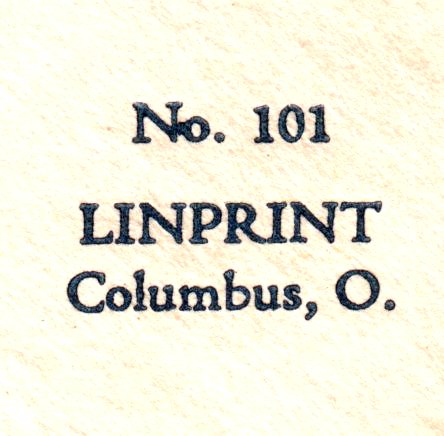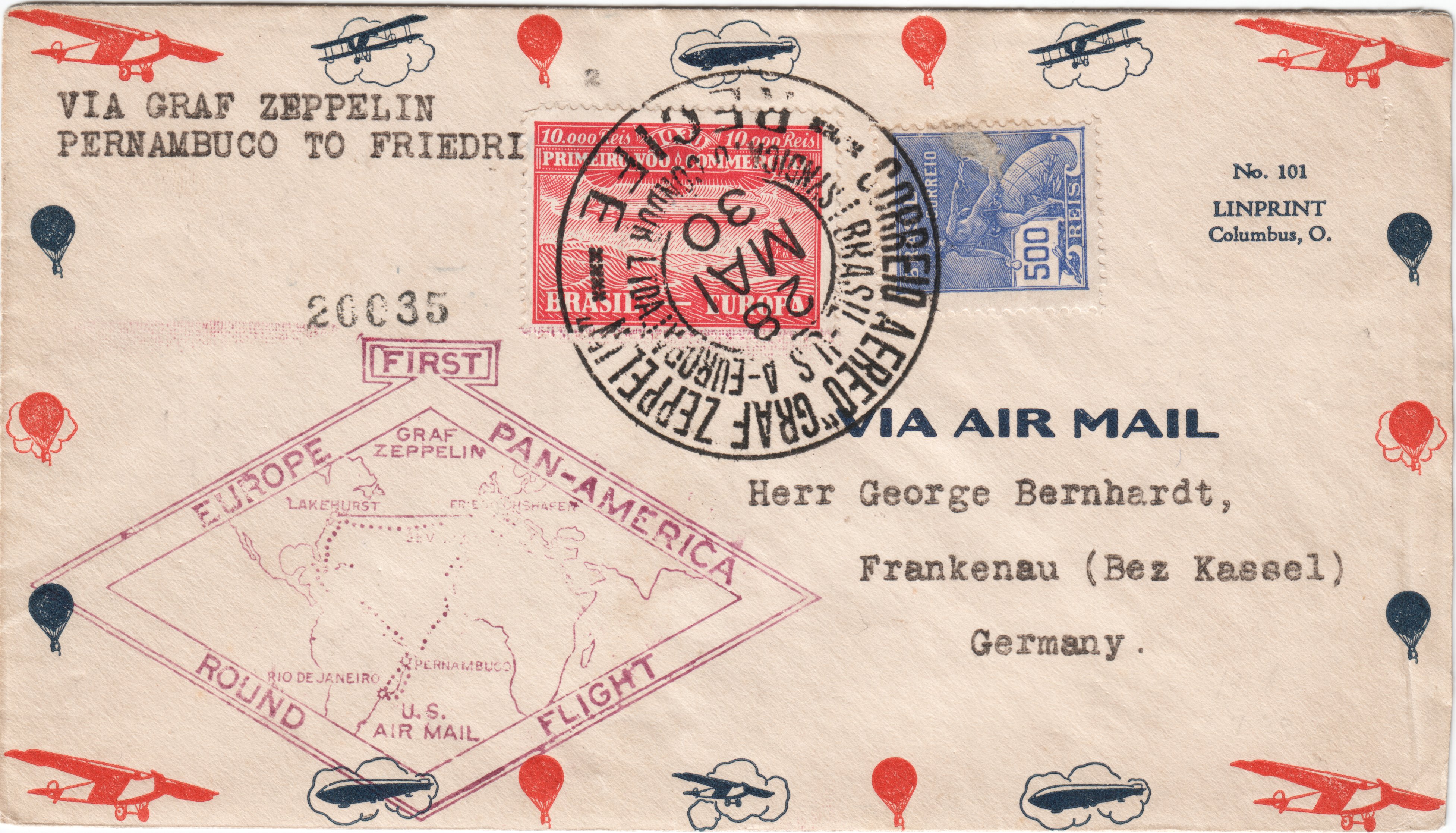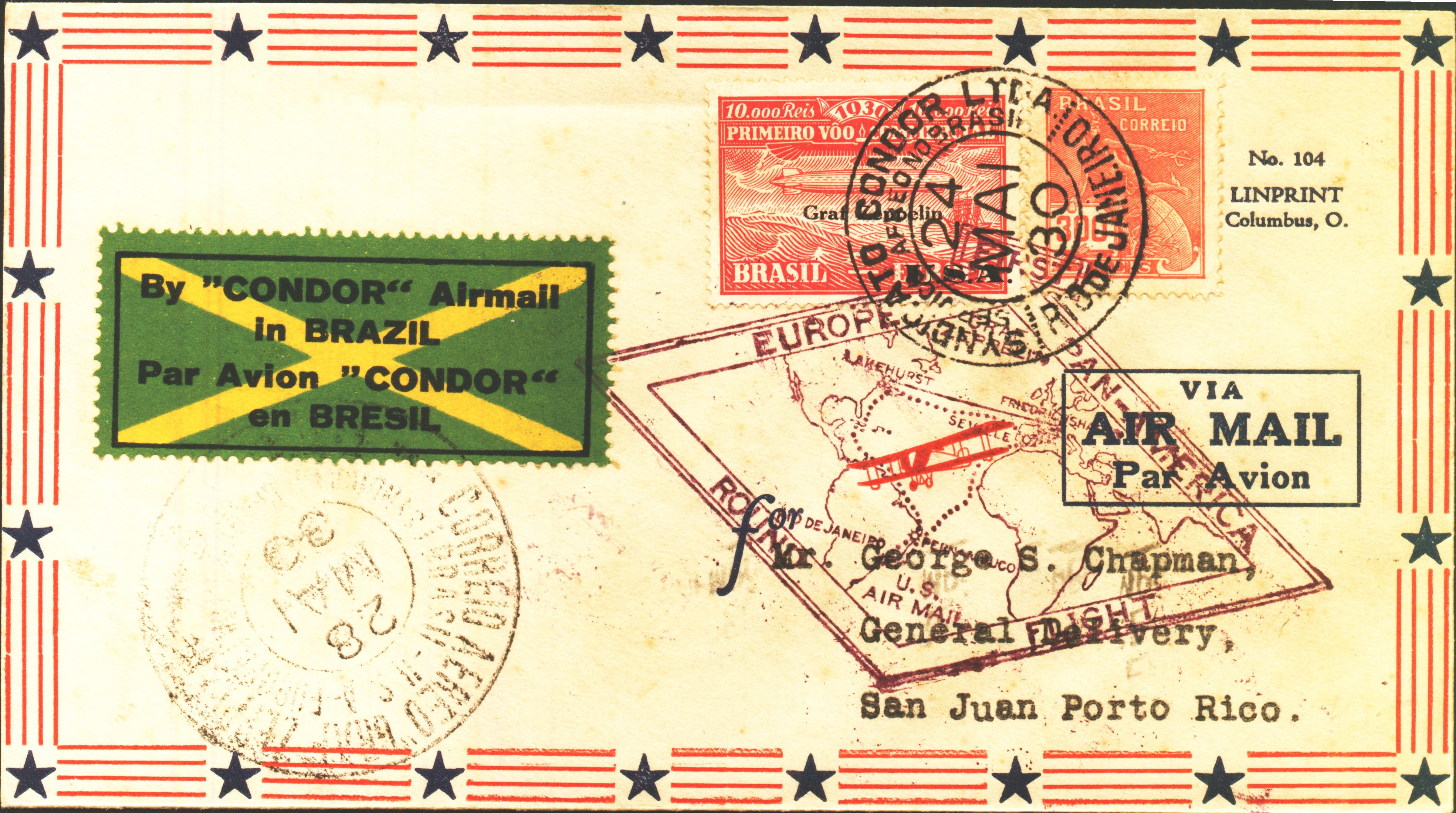|
© Dr. Artur Knoth |
Brazilian Philately: The Pan Am Zeppelin Flight of 1930 |
United States of America:
USPO – Official Stationary: These types of cards and envelopes were often used, probably out of convenience and sometimes to cover supposed extra tariffs (e. g. air mail for inside the USA). I've seen, up to now, six major types, a penalty envelope and a neutral air mail envelope that was “USPO approved”.
1 cent Jefferson postal card:
This was used by a variety of people (R. Thomas-Chicago, W. C. Edwards-Portland and Owen).
1 cent Martha Washington reply postal card:
For years I had this registered as the previous card and now discovered that the stamp actually covers a portrait in green of Martha Washington. Never noticed the reply instructions that are clearly visible.
1 cent/2 cent Martha Washington reply postal card:
Here the older red version, revalued, was used.
2 cent Washington envelope:
Usually the die is covered by the stamp. Envelopes in #6 and #10 have been seen.
2 cent/3 cent Washington envelope:
The older revalued version (#10) has also been seen on this flight.
5 cent airplane air mail envelope:
This has been seen in the #6 and #8 sizes.
Now two cases that don't exactly fit the definition of the previous examples.
USPO Penalty envelope:
USPO “approved” air mail only envelopes:
There are several cases, where commercially manufactured envelopes had various forms of admonitions that these envelopes had been approved by the USPO and where to be used solely for air mail. Below a few examples of the types seen on this flight. Further examples occur further on down, but in those cases the manufacturer's name is known. Some of the examples known up to now are below:
Commercial Stationary: Here one has a whole bunch where I have no idea who produced them and a group where the manufacturer is identified. The variation on designs is impressive and speaks for the elan and enthusiasm of the early air age. We'll start with the cases where we have a name.
Dahlke:
This company, located in Buffalo, N.Y., produced a variety of cards and envelopes. In all cases, the rombi in red and blue that form the border are complete, i. e. no interruption in the upper right hand end for a stamp. Their envelopes also carried the “USPO approved” on the reverse side. This varied if the envelope was #6 or #10 (see below). They also produced a very noticeable postal card, two versions of the Dahlke on the front exist, but the air mail route map is the same. One sees these cards oftener.
Johnson & Clark:
It's hard to overlook one of these envelopes, with their combination of an eagle, stars, via air mails and geometric figures along the border. The identifying copyright is on the reverse, to the left of the bottom eagle. There are two basic variations. The first has red and blue squares in the corner, the other has two triangular red and blue figures.
Linnenkohl:
This case is a bit weird. Basically I have a cover, where he took a Roessler #1 (see Roessler below) and blotted out the Roessler part on the reverse and stamped his own on. Any more like this out there?
Linprint:
It seems besides cacheted FDC envelopes and Linn's Stamp News, Linn also earned money by creating interesting air mail envelopes with unique designs. I've seen #101,2,4 and 5. I have no idea whether there is before 101 and a 106 etc. To this day I haven't seen a #103. Anyone with more info is cordially invited to add to this theme on this site.

 #101
#101
![]() #102
???#103???
#102
???#103???
 #104
#104
 #105
???#106???
#105
???#106???
Luxwood:
The front of a the envelope is just like in the case of Dahlke, but on the reverse the name appears.
Roessler:
Roessler is a chapter for himself. To see the specific Zeppelin cards/envelopes used link to the Roessler file and a New Jersey dealer that had his own printed by Roessler, Bernet. Here I'll just show two envelopes that were for general use. The first “normal” looking envelope is the type used by Linnenkohl, note that a space for the stamp has been created. The second is a more exotic version with a fancy border.
The Nameless:
The next couple examples are some very interesting designs, but where there is no mention or indication of whom we have to thank for these designs.
Blue-White-Red Stripes:
I've found four different variations on this in my collection. The first seems to stem from the same person – Frank Mitchell Wright. The next two are #10 envelopes and the last has the strips on the top.
Red-Blue Triangles:
Red-Blue Planes:
This type occurs often, and seems to be mainly used by Bill Schneider and Co. Design both sides.
Airmail Special Design:
This very intricate design I've only seen once, only on the front.
Blue Globe with Planes and Zeppelin:
This corner card type design I have several of in my collection.
Plane + Cloud Corner Card:
This seems to be an add on to normal envelopes, below two versions.